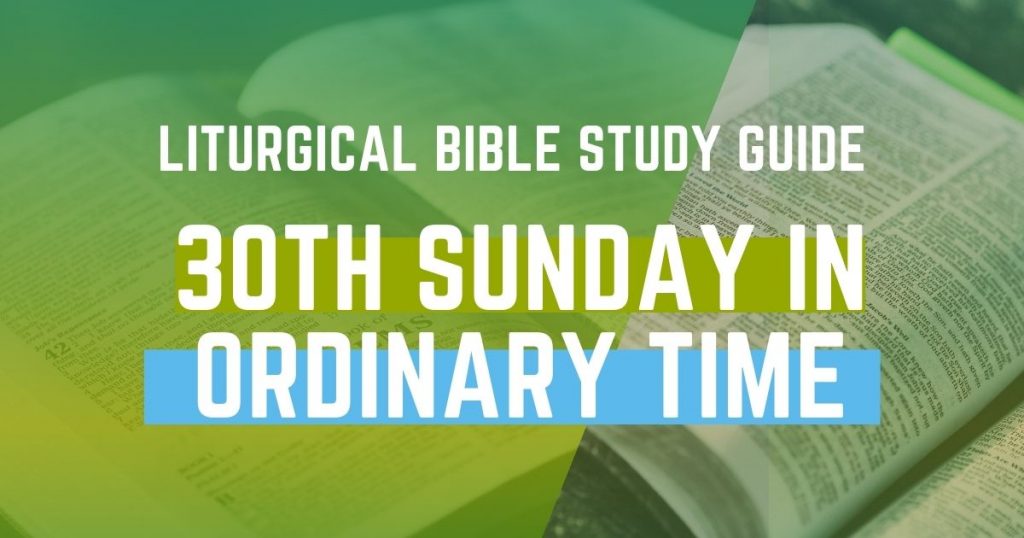1st Reading – Jeremiah 31:7-9
Jeremiah was the second of the four great prophets of Israel, a contemporary of Zephaniah, Nahum & Habakkuk. He was born around the year 645 B.C., almost a century after Isaiah. He came from a priestly family in Anathoth, a town about three miles northeast of Jerusalem, in the southern kingdom of Judah.
God called him to be a prophet in 626 B.C., when he was 19 years old. By express order of Yahweh he remained unmarried (Jeremiah 16:2), embracing celibacy with generosity. God’s call came to him at a time when the kingdom of Judah was about to collapse. Although he preferred a quiet family life and small-town friendships, he realized he could not contain the sentiments God had placed in his heart. For more than 40 years, up to his death, he remained faithful to his vocation and prophesied until after the fall of Jerusalem in 586 B.C. When Jerusalem fell, Jeremiah was forcibly taken to Egypt by his fellow Judahites. In Egypt, Jeremiah prophesied against idolatrous Jews, and probably died soon after, either stoned or starved to death by those same men, who could not take his criticism.
Jeremiah’s book tells of his calling to be a prophet and chronicles the downfall of Judah through mistaken covenants and broken covenants. He reminds his hearers that God is a just judge who takes covenants very seriously. He then goes on to prophesy about the restoration of the northern and southern kingdoms (Israel and Judah). Today’s reading talks about the restoration of Israel and the new exodus.
2nd Reading – Hebrews 5:1-6
As we continue on with our study of the book of Hebrews let’s look at its location in the New Testament. The New Testament epistles (wisdom books) are located after the legal books (gospels) and the historical book (Acts) and before the book of prophecy (Revelation). The wisdom books are further divided by author (Paul, James, Peter, John, and Jude), and within each author by length with the longest appearing first. The author of Hebrews is unknown. As recently as 1914 the Pontifical Biblical Commission reaffirmed that the Church has not decided that St. Paul is the author. That is why the reading is simply announced as “from the letter to the Hebrews.”
The book is located in the New Testament after the epistles of Paul and before those of Peter; quite possibly because of its length. The basic teaching of the Letter to the Hebrews centers on showing the superiority of the Christian religion over Judaism. This argument develops in three stages:
1) Jesus Christ, the incarnate Son of God, is superior to the angels, although He became less than the angels to lead us by example.
2) Christ is superior to Moses. This is the reading the Episcopalians and Lutherans heard 2 weeks ago.
3) Jesus, the Son of God, is the great high priest. His priesthood is of the order of Melchizedek, superior to the priesthood of Aaron, from whom the Levitical priesthood is derived.
Who is this Melchizedek? We know very little of him through what is recorded in Holy Scripture, but the Jewish targums [Aramaic translations and paraphrases of the Old Testament which came into use after the exile (586 B.C.)] and other writings make it very clear that Jewish tradition identifies him as Noah’s firstborn son, Shem. Melchizedek is his throne name (just as John Paul II is the throne name of Karol Wojtyla).
“When Abraham returned from the war, Shem, or, as he is sometimes called, Melchizedek, the king of righteousness, priest of God Most High, and king of Jerusalem, came forth to meet him with bread and wine” [see Genesis 14:17-18] (Ginzberg, Louis, Legends of the Bible, Jewish Publication Society of America, Philadelphia, 1956, page 106).
How can this be? Noah lived many years before Abraham. After all, it was Noah and his descendants who repopulated the world after the flood and there are lots of people around when Abraham is living. Let’s look at Genesis 11:10-26 for a few minutes. This passage traces the genealogy of Abraham (or Abram as he was known before God changed his name) from Shem, Noah’s firstborn son. From this passage, if we do the math, we find that Shem lived for six hundred years; and in fact, outlived Abraham, who himself lived to be 175, by 35 years. Did people really live that long back then? We don’t know, but the sacred author certainly wants us to be able to see the connection between ShemMelchizedek and Abraham.
Why is this connection important? Because it traces the priesthood of the family. As we follow the blessing through Scripture we find that in Genesis 9:1, 9 Noah is blessed by God and in Genesis 9:26 Shem is blessed by Noah. The next mention of the blessing is in Genesis 14:19 where Abram is blessed by Melchizedek. Later, Isaac is blessed and then Isaac passes the blessing on to Jacob instead of Esau, as he had intended. When he finds that he has been deceived, Isaac tells Esau that the blessing cannot be taken back and describes the effect of this priestly ordination “I have already appointed him your master, and I have assigned to him all his kinsmen as his slaves” (Genesis 27:37). This is the priesthood of the order of Melchizedek, the priesthood of the family.
Gospel – Mark 10:46-52
Last week we heard Jesus’ third instruction on Christology and discipleship. These three instructions can briefly be summarized as follows:
1) Jesus must suffer and die and in 3 days he will rise.
2) The disciple must forsake all earthly impediments and depend totally upon God. Trust and serve like a child.
3) The humble disciple will receive earthly rewards for his service – including persecution. The persecution will help form his spirit in reparation for entering the kingdom of God.
This week we hear of the healing of blind Bartimaeus. In Mark 8:22-26 an unnamed blind man is brought to Jesus, has his sight restored gradually, and is told to keep his healing a secret. In today’s story, Bartimaeus actively seeks out Jesus, is healed immediately, and becomes a disciple on the way. This second story, the last before Mark begins his description of Passion Week, illustrates some progress in faith. It is as much a call story as a healing story. Bartimaeus’ reaction to Jesus and his willingness to follow Him on the way of discipleship contrast with the disciples’ misunderstanding and blindness during the journey.


